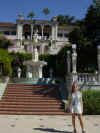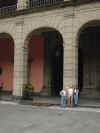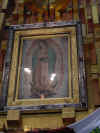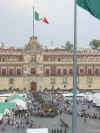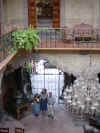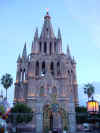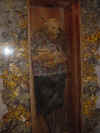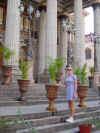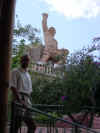| The Lustik Travel Home Page |
October 1 - 15, 2002
Tuesday, October 1, 2002 Watsonville, CA
I woke up feeling pretty lousy with a headache, sore throat and head congestion. We scrapped our plans of motorcycling today and took a more relaxed pace. We drove up to Santa Cruz and did all of our laundry before settling on the beach for a couple hours of sunbathing. Santa Cruz is a very liberal town that seems to be stuck in the sixties. It has a well-preserved boardwalk and wharf along the city beach. This area includes an arcade and old-style amusement park attractions, but everything was closed up this late in the season. We had perfect weather for lying in the sun and listening to the barking seals echoing from under the pier.
We returned to our campground and Christine went back to work on her masters project. She is determined to get it finished this week and has been working steadily on it since Saturday.
Wednesday, October 2, 2002 Big Sur, CA
We lingered at our campsite as Christine spent the morning getting more of her project posted on the internet. It was a clear day along Monterey Bay as we drove down to the Monterey Bay Aquarium. This is one of the finest saltwater aquariums in the world. We really enjoyed the exhibits, especially the anemone and jellyfish tanks. The aquarium did an excellent job of illuminating the fish to bring out their beauty. We watched an “in the tank” feeding of sharks, and we were later amused by the feeding of the otters. The aquarium is located in an old fish canning building along Cannery Row. We stepped outside to watch wild otters feeding in the kelp-rich bay, and harbor seals basking on rocks. This aquarium really blurs the lines between captive and wild.
Cannery Row was a bustling industrial site during the peak of sardine fishing off the central California coast, from about 1905-1945. Eventually the sardines were “fished out” of this area. Cannery Row was the subject of much writing by John Steinbeck, who spent a lot of time in the Monterey area. We walked amongst the tourist shops that have now revitalized Cannery Row into an attraction for visitors.
We continued to explore the area on this fine day by driving scenic 17-mile Drive through the Pebble Beach area. This road winds along the rocky coast just south of Monterey Bay and brings the tourist close to amazing trophy homes nesting about the hilly shores. Several world-class golf courses add to the natural allure of this destination. We were surprised by the scores of deer casually loitering on the golf course fairways. The black-tail deer seem to be in rut, judging by the persistent bucks chasing after the does. We also saw several other gatherings of harbor seals or sea lions (it’s hard to tell the difference from a distance) resting on rocks in the water. It was indeed a pretty drive.
We continued south in the later afternoon along the Pacific Coast Highway (Hwy 1) down to Big Sur where we found a quiet campground squeezed in between a stand of coastal redwoods and spent the evening on our computers.
1) Real jellyfish at the aquarium. 2) A sea otter floating outside the aquarium. 3) Seal lions of the coast of Pebble Beach. 4) Black-tailed deer enjoying the perfect grass on the golf course. 5) The CA coast on the Pebble Beach drive. 6) A coastal picture. 7) The lone cypress is a symbol of strength at Pebble beach.
Thursday, October 3, 2002 Bakersfield, CA
We meant to get an early start this morning. We are accustomed to having the sun wake us, but we were cloaked in darkness under the shade of giant redwoods until I finally checked the time at 9:00. Oh well… It turned out to be another beautiful day to be driving along the coastal range. We wound our way down to San Simeon to visit the eclectic estate of William Randolph Hearst, familiarly called Hearst Castle.
Hearst was an only child born into mining wealth in 1863. He was spoiled as a child and traveled extensively. Hearst was kicked out of Harvard and convinced his father to give him control of a San Francisco newspaper at the age of 24. Hearst doubled the paper’s circulation within two years and kicked off the buildup of a media empire. In its peak, the Hearst conglomerate owned newspapers in most major U.S. cities, published many familiar magazines, produced a regular newsreel for early cinema, and ultimately produced scores of Hollywood films. Hearst also served in congress and was active politically his entire adult life.
Hearst’s father had acquired the coastal area of San Simeon when W.R. was only two years old. The family enjoyed rustic vacations there camping in the hills. Hearst inherited all of this in 1919 when his mother passed, thus began the project of building a dream house there. Hearst spent the next 30 years in a productive collaboration with Julia Morgan, his architect. Hearst died in 1951 at 88 years of age, and he still hadn’t finished building the estate. It is apparent that the process of design, redesign, and construction brought him great joy, so he refused to put an end to it all. Construction of the main house remains unfinished.
Hearst and his castle were lampooned by Orson Welles in the movie “Citizen Kane.” The castle was a hodgepodge of Gothic, Baroque, Renaissance and Mediterranean styles. It appears excessive in every respect. We had a very good tour guide walk us through part of the estate. We saw the famous Neptune Pool, one of the guesthouses, and several rooms in the main house. Hearst entertained regularly here drawing often from the pool of Hollywood celebrities that he got to know through his film business and through his relationship with his mistress, actress Marion Davies.
Hearst used much of his land to support the largest private collection of zoo animals in the world at that time. A few of the animals remain as residents on the land. We saw a large group of Moroccan bighorn sheep on our approach to the house, and later we saw a dozen zebra grazing with cows along the highway. How odd to see zebras along the roads of coastal California.
We turned the RV east toward Bakersfield to keep an appointment I made to get service done on the RV tomorrow morning. We passed dozens of vineyards and wineries as we bisected San Luis Obispo County, the states 4th largest wine region. The conditions are so conducive here for growing the grapes for merlots, cabs, and red zins that many Napa and Sonoma wineries have vineyards down here. We had an easy drive back to Bakersfield as Christine crunched on the final effort of her masters project. We hope that this will truly be the last push.
1) A view of the castle through a telescope. 2) A view of the Hearst castle from down the hill. 3) These steps go up to a one of the many guest houses. 4) The famous outdoor pool. 5) This is the front of the main house. 6) This is the Indoor pool.
Friday, October 4,
2002
Santa Maria, CA
We
got started pretty early and spent the morning in the customer lounge of the RV
service center. Christine submitted
the final (we hope) revision of her masters project and will have to wait to
hear for sure. The RV was serviced
efficiently and we were out of the service center at 1:30.
We spent the afternoon running a few errands in Bakersfield before
heading back over toward the coast. We
found a campground in Santa Maria for the night. I grilled out some pork tri tips and we ate late.
Saturday, October
5, 2002
Buellton, CA
We enjoyed a great morning. Christine checked e-mail and got confirmation that her masters project was accepted and her final grade was posted. Her elation may have surpassed the joy of finishing the JMT. I am so proud of the way she pursued this graduate degree over the past 2.25 years without a break. She really stuck with it and managed to get straight A’s while still enjoying all the diversions that we undertook on our travels.
We went for a four-mile walk along the city’s bike/walk path and cleaned up before driving into town to attend the annual Autumn Arts, Grapes and Grains Festival. We watched some chalk artists and ate lunch before entering the wine and beer tasting area. One price got us inside where we could sample from about 40 regional microbrews and about 100 area wines. We started out with wine, but it was really more of a beer day.
After we had tasted all that we could handle we drove further south to Buellton for the evening. We celebrated Christine’s completion of school by eating out at Pea Soup Anderson’s Restaurant. This establishment has been serving up its renowned split pea soup since the 1920’s. We had a pleasant evening.
The sore throat and congestion that I first mentioned on Tuesday has developed into a severe chest cold. The indulgences of this afternoon at the beer and wine tasting festival did not improve my condition any. I’m hoping to shake this cold before we fly to Mexico City on Wednesday.
Sunday, October 6, 2002 Simi Valley, CA
We enjoyed a quiet Sunday morning drive down toward L.A. along the Ventura Highway. We had made plans to visit my Aunt Dorothy in Simi Valley. We arrived shortly after noon and spent the day visiting with her. Later my cousin Annie joined us with her husband, Oren and their son, Samuel. We all sat down to enjoy a great salmon dinner that my aunt prepared for us. We really had such a good time catching up with each other and reminiscing on life in Cincinnati, the primary home of our youth.
Dorothy, Annie, Samuel, and Oren
Monday, October 7, 2002 Indian Wells, CA
Christine and I got up early to join my aunt on a hike with her weekly hiking group. Eleven of us gathered in Malibu Creek State Park to take a 5-6 mile hike through the Santa Monica Mountains. It was a very hot day, but the area was beautiful. We even got to walk through the abandoned set where M*A*S*H was taped. It was interesting to imagine that we were in South Korea.
Aunt Dorothy’s walking group is mostly comprised of other retired persons intent on keeping healthy and active. They were all very interesting people and made Christine and me feel very welcome. Some of these people have fascinating stories and outstanding energy levels for their age. Gabi is an 89-year-old woman that could run circles around many people half her age. I applaud their commitment to healthy active lifestyles. I, on the other hand, nearly collapsed from the combination of my chest cold and the heat of the day. It was just too much for me to take on until I get over this cold.
The whole walking group breaks out a bag lunch after the hike before going their separate ways.
Christine and I returned to Dorothy’s house and we took a couple quick showers before hitting the road toward Phoenix. We got as far as Indian Wells with only periodic traffic slowdowns. We made sure to choose a campground where we could tune into Monday Night Football. It was a good night as the Packers dominated the Bears. It’s hard to believe that this is the first Green Bay game that we’ve gotten to watch this season. At least it was a good one.
Tuesday, October 8, 2002 Tempe, AZ
We got an early start to finish the drive to Phoenix. We spent the afternoon preparing for our early departure to Mexico City tomorrow, and we finally got our website updated with the log and photos from the John Muir Trail. That was a big job. We’re looking forward to seeing our friends Ken & Luma tomorrow.
Mexico
Wednesday, October 9, 2002 Mexico City, Mexico
We woke at 5:30 AM to catch our flight to Mexico City. There were no complications and we arrived at 2:40 PM, just five minutes after our friends Ken & Luma arrived. We all got through immigration and customs and took a taxi to the Cathedral Hotel near the Zócalo in Mexico City. We checked into our satisfying rooms on the 5th floor, ours had a view of the Metropolitan Cathedral. We took a break before heading out on foot to check out the town.
Our entire itinerary of travel in Mexico will have us covering a lot of historical locations, so I’m going to interject an insultingly brief history of Mexico to put things into perspective. Mexico’s history may be divided into four eras: Pre-colonization (before 1519), Spanish Colonialism (1519-1810), Independence (1810-1910), and Revolution (1910-present).
There are still over 50 indigenous languages being spoken in Mexico. Many of these are derivatives from the ancient peoples that populated this country for thousands of years before discovery by Spain. The highly developed cultures of Olmec, Maya, Toltec and Aztec left significant imprints on the land, including palaces, pyramids and temples. The Maya people are credited with the concept of ‘zero’ and highly accurate calendars that could predict astronomical events. These cultures did not develop a written language, leaving many unanswered questions about their history.
In 1519, Hernán Cortés arrived in Mexico and penetrated the inland with several hundred soldiers and conquered the mighty Aztec nation under the rule of Montezuma. This began a severe period of colonization and Catholic conversion that lasted three centuries. The Spanish left their mark socially through the formation of cities styled after cities in Spain at that time. These cities are all built around a central square or plaza. The Spanish tapped into rich gold and silver mines and used this wealth to build over 10,000 Catholic churches. Over the centuries of Spanish presence, the racial clarity between the Spanish and indigenous peoples was steadily diluted. The interbreeding resulted in a mixed race of mestizos that now forms the majority population in Mexico.
On September 15, 1810 Father Miguel Hidalgo gathered his parishioners in the town of Dolores Hidalgo and delivered the ‘Grito de Dolores’ (Cry from Dolores), a stirring speech pleading the people to pursue independence from Spain. This speech launched the war of independence that lasted for eleven years. The Republic of Mexico was formed December 6, 1822 when General Santa Anna (the same one that defeated the Texans at the Alamo) became president. The new country struggled as the government changed hands 30 times over a 30-year period. The conflict over the border with the U.S. from 1836-1847 resulted in the Mexican-American War and the loss of a huge swath of land including sections of CA, NV, AZ, UT, NM, CA, and TX. Years following included a new liberal constitution that aimed to reduce the stronghold still held by the conservative Catholic Church. Chaos at this time made Mexico vulnerable to foreign conquest. England, Spain, and France all initiated steps to add Mexico to their respective empires. Only France carried out an attack, losing on Mexico soil in May, 1862 (still celebrated today as Cinco de Mayo Day). Benito Juárez was the liberal visionary trying to lead Mexico during these years. He suffered defeats as European viceroys and archdukes controlled the government with the backing of conservative Mexicans. Juárez is revered today as Mexico’s Abraham Lincoln.
Porfirio Diáz ran the country as a dictator from 1876-1910, modernizing the economy, but increasing the division between the ‘haves’ and ‘have-nots.’ This led to the Revolution from 1910-1920. The revolution years saw major division and hardship with 12% of the population perishing for their causes. Questionable players like Pancho Villa and Emiliano Zapata organized guerilla movements that continued to undermine stability. General Cárdenas was elected in 1934 and began the long ongoing social reform of Mexico.
We walked out to the Zócalo and stopped for a couple beers and a midday taco snack at a sidewalk café. The Zócalo is the center plaza of Mexico City’s Historical District. It is the second largest city square in the world, next to Moscow’s Red Square. The Cathedral sits on the north side of the square, and the National Palace sits on the east side. A massive Mexican flag flies from the center of the square. The Zócalo is comparable to our National Mall in Washington, D.C. This is where most organized public protests are held, as well as public concerts and festivals.
We were overcome by rain as we finished our snack. None of us had brought umbrellas so we dashed into temporary vendor tents on the Zócalo housing exhibits and wares of indigenous Mexican tribes. This cooperative of native arts and crafts was mixed with political promotional materials and speeches informing people about the plight of these peoples. I sampled some foods and had a great cup of organic coffee.
We dashed into the Cathedral to continue waiting out the rain. The Cathedral is massive, built between 1573-1788. It is in peril as it sinks into the lakebed on which it was built. Everything is out of true and askew. Electronic monitors are hooked up everywhere tracking the tilt/twist of the walls/columns. Permanent scaffolding and tension lines prop up the building. The cathedral is built on the site of an ancient Aztec temple that was destroyed by Cortés and his missionaries to make room for the Cathedral. This is the ultimate statement of “My god is greater than your god.” The Cathedral was even constructed from the stone of the old temple. The Cathedral has 4 naves and 14 chapels, and is clearly in the middle of serious preservation efforts, but it all seems futile in the long run since the land underneath is too soft to support a structure of such mass.
We finally tired of waiting for the rain to stop, so we scampered back to our hotel to dry off and clean up before a late dinner. We borrowed a couple umbrellas from the hotel and walked all the way to Garibaldi Plaza, mariachi central. We saw at least a dozen mariachi bands decked out in costumes waiting for clients to invite them to perform at a party somewhere. This happens every night here, rain or shine. We enjoyed a typical Mexican dining experience of la comida corrida, a multi-course fixed price meal, for just a few $U.S.
We were greeted by a break in the rain after dinner. We walked to the Palace of Fine Arts, a very clean and impressive building with an amazing art deco reception hall. We watched part of a concert performance on the closed circuit TV in the lobby. We returned to the hotel stopping to see the Tiffany-like stained glass canopy suspended over the atrium of the Gran Hotel. Jacques Gruber created it in 1908. We reached our hotel weary from our first day in Mexico.
1) The Metropolitan Cathedral. 2) The Palace of Fine Arts
Thursday, October 10, 2002
Mexico City, Mexico
We walked to a fine bakery for a breakfast of fresh breads. We then set out to explore the Historic District on foot. We visited the Great Temple Archeological Site, the most important religious structure in the ancient Aztec capital of Tenochtitlán. History says that nomadic Indians from the north made their way to the Valley of Mexico in 1325 to fulfill a prophecy that they were destined to settle where an eagle, carrying a serpent in its beak, was perched on a cactus (this image appears on the Mexican flag). According to legend, the spot was an island in the middle of Lake Texcoco. This is where the great city of Tenochtitlán was built.
The Aztecs gradually filled in a large portion of the lake to create a massive island city crossed by canals and connected to the mainland by causeways. The city had a population of about 300,000 by the time Cortés arrived, possibly the largest city in the world at that time. Mexico City is now built on this site, and suffers from the poor foundation of sitting on landfill. Mexico is the 14th most populous country in the world with about 100 million, but about 25 million of these people reside in and around Mexico City, making it one of the largest cities in the world.
Cortés overwhelmed this city by luck. He scared them with canon fire and horses, foreign concepts to the Aztecs. He also allied himself to many resentful subservient tribes that were only too glad to end the domination of the Aztecs. But he most benefited from mistaken identity. Montezuma II, the Aztec leader, believed that Cortes was Quetzalcóatl, a fair-skinned, golden-haired god of Aztec myth.
There is a good scale model of Tenochtitlán near the dig site that shows how the city might have appeared to Cortes. We then went into the National Palace, bordering the east side of the Zócalo. It stands where Montezuma’s palace once stood. Until recently it was the office of the leaders of the country. It is best known now for the series of Diego Rivera murals adorning the walls of the second floor around the courtyard. The murals took 25 years to complete and they depict political, social, and spiritual events in the history of Mexico. There are several blank walls remaining that were to be painted by Rivera, but he died before he could get to them. The murals are outstanding and take a while to decipher.
We purchased umbrellas for each of us from a sidewalk vendor and then walked a ways to Alameda Park to the Diego Rivera Mural Museum. It houses his epic mural “Dream of a Sunday Afternoon in the Alameda Central,” which had originally been painted on the wall of the Hotel del Prado across the street. The hotel was torn down after the great 1985 earthquake, but the mural was saved and moved to this museum. The museum does a great job of identifying and interpreting all the features of the mural.
We hopped on a city bus up to the Basilica of Our Lady of Guadalupe. In December of 1531 the Virgin allegedly appeared three times before an Indian peasant named Juan Diego, and asked that a church be built on the hill at that site. Juan Diego took this message to the bishop, but was asked for proof that the Madonna had appeared before him. Diego returned three days later with an armload of roses (a miracle since they were out of season) and a vivid image of the dark-skinned Virgin on his clothes. A church was finally built in 1660 atop the hill, and the first basilica was erected in 1709 to house the sacred image of the Virgin. The first basilica remains, but is sinking so badly into the lakebed that a new modern basilica was built next to it in 1976. The holy cloth with the image of the Virgin hangs above the altar. We were able to the see the cloth up close from an opening beneath the Altar. This site ranks up with Lourdes (France) and Fatima (Portugal) as holy ground in the Roman Catholic Church. It is of prominence recently due to the Pope coming here on July 13th this year to canonize Juan Diego into sainthood. The grounds of the basilica were a mess. Many poor pilgrims come to this site and sleep in the courtyard building fires and leaving their garbage.
We ate a cheap lunch near the basilica and then took a bus back to town to check on our rental car for tomorrow morning. We then walked around the Zona Rosa, the more touristy part of Mexico City. It has nicer hotels, restaurants and shopping, attracting most Americans to stay here. We returned to the Zócalo and had cocktails atop the 7th floor of a hotel overlooking the plaza. We arrived in time to watch the twice-daily (not always) flag lowering ceremony. A 50-member brass band provided a prelude performance. A 120-member drum and bugle corps marched onto the square followed by a 100-member color guard to execute the ceremonial lowering. It was a very special site from our high perch—lots of pomp and circumstance. We returned to the hotel for a rest before dinner as the rain began to fall. We went back out for a simple dinner.
By Christine: We really had a full day today. I enjoyed the walking, the buses, and the sites, but I do not enjoy how dirty Mexico city is in it's streets.
1) This is the scale model of the Aztec city of Tenochtitlán. 2) The National Palace. 3) The inside of the National Palace, note the military guys chatting near us. 4) The inside of the National Palace. 5) One of the Diego Rivera murals inside the National Palace. 6)Inside the new Basilica. 7) The shirt showing the Virgin of Guadalupe. 8) Gardens near the original Basilica. 9) The Zócalo and the National Palace. 10) The beginning of the flag ceremony in the Zócalo.
Friday, October 11, 2002 Querétero, Mexico
Ken and I got up early to go pick up our VW Jetta rental car for the next week of exploring. We all enjoyed a nice breakfast at the hotel and then left busy Mexico City before 11:00 to visit the pyramids of Teotihuacán. The ancient city was begun in 700 B.C and was burned and abandoned around 750 A.D. The construction of the pyramids began in 100 B.C. going through nine different periods of building. The city’s population peaked at 200,000 around 500 A.D., bigger than Rome at the time.
The ruins are situated along a 7-mile Avenue of the Dead, of which only two miles are currently revealed. Two pyramids: the Pyramid of the Sun (250+’ makes it the 3rd largest in the world) and the Pyramid of the Moon (140’), and The Citadel containing the Temple of Quetzalcóatl. Christine and I climbed to the top of the Pyramid of the Sun, and I went halfway up the Pyramid of the Moon. It was a beautiful day and the smog had really cleared as we left Mexico City. The archeological site was very impressive and quite well preserved. We enjoyed not having to deal with large crowds, just a few groups of obnoxious school kids. I think kids of that age are obnoxious anywhere in the world.
We drove on out to Querétero (elev. 6078’, pop. 450,000), about 140 miles nothwest of Mexico City. We stayed at a fabulous old inn, La Casa de la Marquesa, our most upscale lodging of the entire trip. It is a fabulous old mansion with claims to royalty, and has been converted into a 14-room inn. Querétero claims to be the origin of plans for the War of Independence in 1810, though Dolores Hidalgo is credited with the speech that started the war. The city also served as the capital of the country on multiple occasions and is where the current constitution of 1917 was drafted. The historical district of Querétero is exquisitely maintained and absolutely spotless. It was such a contrast to the polluted sprawl of Mexico City. We walked around this prosperous city and chose a good restaurant for dinner. We enjoyed an after-dinner walk and found some ice cream before returning to our hotel. Christine and I sat in the great hall of our inn and listened to a violin-piano combo as we sipped on some Kahlua before heading to bed. It had been a very nice evening.
1) The pyramids of Teotihuacán. 2) The Temple of Quetzalcóatl. 3) Pyramid of the Moon. 4) The view back down the Avenue of the Dead from the Temple of the Moon.
Saturday, October 12, 2002 San Miguel de Allende, Mexico
We got a slow start and enjoyed a nice breakfast before taking in a 1-hour trolley tour of the city. Ken & Luma translated the guide’s narrative for us, including the jokes. We got to see the aqueduct, a Querétero landmark. It was built between 1726 and 1738 and extends nearly a mile over 74 stone arches that reach up to 69 feet high. It was in service for over a hundred years and is very well preserved.
We left Querétero and took a short drive northwest to San Miguel de Allende (elev. 6134’, pop 50,000), a small historic city built on the side of a hill. Seeds of the War of Independence were sown here, so preservation efforts have helped the city survive the decline of mining revenue. San Miguel de Allende has a very large population of North American ex-patriots that reside here part-time or full-time. This has caused a rapid inflation in home values and an influx of cash into the retail economy.
We were able to rent a house for our two nights here. The lovely house belonged to a (retired) couple from Pittsburgh that had to return to the states to supplement their retirement income after the market took a nosedive, and a restaurant venture failed. The house was beautiful, but it wasn’t ready for our arrival. We waited several hours before someone showed up with a key. Fortunately, we were offered the hospitality of a neighbor that invited us in and served us drinks while we were told what it was like to be an American living here. Ally, our host, has been living here with his wife for much of the year, going on six years now—and loves it. The rest of his family is in Louisiana. We really enjoyed his company.
We finally got into the house and found it unclean, but manageable. We cleaned ourselves up and went into town for a nice meal and listened to a large band playing traditional Spanish music in the town square.
1) The inside of the Hotel de Marquis was wonderful and most of the walls were covered with decorative tile. 2 and 3) The Queretaro aqueduct. 4) Independence square in Queretaro.
Sunday, October 13, 2002 San Miguel de Allende, Mexico
Christine suffered a bout of stomach sickness that had her up much of last night, but we came prepared with some Immodium and it was calming her system down by the morning. We were glad to be staying here a second night so Christine could enjoy a day of recovery.
We headed out in the afternoon to visit the Talavera pottery factories in Dolores Hidalgo, about 30 miles north of San Miguel de Allende. Dolores Hidalgo is recognized as the cradle of independence. It was here around midnight on 9/15/1810 that Father Miguel Hidalgo rang his church bell to gather the parishioners to hear his speech (Grito de Dolores) pleading people to rally against Spain. An eleven-year war followed to achieve it, and now Mexico observes September 15th as Independence Day. This area is also famous for the inexpensive fine pottery produced from a large number of artisans. The colors and designs of the glazes vary considerably between producers. We were shut out of many shops that were closed for Sunday, so we planned to come back here tomorrow on our way to Guanajuato and do some shopping.
We leisurely returned to San Miguel De Allende and decided to pick up some pizzas for dinner and return to the house. We hoped that this food would agree more with Christine’s sour stomach. After eating some pizza we all left Christine at the house and went back into the town to see more of the sights. It was a very nice evening to mill about with all the locals enjoying their day of rest. We returned home and relaxed with some nightcaps before bed.
By Christine: I've been looking forward to the pottery and I was disappointed many shops were closed. But I am glad we are coming back tomorrow as I just didn't have the energy to make the decisions needed in a good shopping spree.
1) A view of San Miguel from above the city. 2) The cathedral in San Miguel was a little different and they lit it up nicely at night.
Monday, October 14, 2002 Guanajuato, Mexico
We packed up and hit the road at 9:00 returning to Dolores Hidalgo. Christine and Luma shopped for pottery and scored some good deals. We then enjoyed a scenic drive over to the mining city of Guanajuato (elev. 6649’, pop. 70,000) west of Dolores Hidalgo. This is a very unique city nestled between the walls of a canyon. Guanajuato suffered from so many floods that the Rio Guanajuato was finally diverted away from the city in 1905. The former path of the river was turned into an underground thoroughfare and has since then been added to by several tunneled roadways beneath the city. This makes negotiating the city by car one of the most disorienting endeavors I’ve ever undertaken. Fortunately, we all injected our good sense of humor into the pursuit of a route to our lodgings.
Guanajuato is a very lively town. For several hundred years the mines of Guanajuato produced one-third of the worlds silver. Mines are still producing silver, gold and lead in the area. A large contributor to the town’s atmosphere is the highly regarded Guanajuato University. A university tradition of performing skits based on the writings of Miguel de Cervantes has matured into the International Cervantes Festival that occurs here annually in October. We are fortunate to be here for the 30th anniversary of this festival, which increased the liveliness and density of the town.
We found our modest hotel after negotiating the underground maze with our rental car. The streets are so narrow that there was no room to park, so we unloaded our bags and then let Ken park the car with the aid of a hotel escort. The four of us share a two-bedroom suite here for these next two nights.
The streets are so narrow that the town begs to be explored on foot. Many of the roads have now been closed to vehicle traffic, improving the pedestrian flow in the town. We walked out and found a nice restaurant in front of the Juarez Theatre where we enjoyed an enormous lunch. We then explored the bustling city and took in the Mercado (indoor Mexican market). Our large lunch overwhelmed Christine’s still sensitive stomach. She chose to stay in the hotel tonight.
Ken, Luma and I took a taxi out to the State Theatre to see an outstanding modern ballet interpretation of Carmen. Luma had arranged for the tickets to this ballet and another event tomorrow night while making the reservations for our lodging here. We were able to pawn off Christine’s ticket at the theatre. The theatre was full for this Cervantes Festival performance. We returned to town and walked around finding snacks that would suffice for a late dinner.
By Christine: I was feeling much better this morning and was properly able to enjoy my pottery shopping spree. The prices are so amazing and I found a traditional pattern that I think will really match my dishes. Anyway I think I remember what the dishes look like since they've been in storage for 22 months! I was not happy to have the cramps return this afternoon. I hope I am able to shake this annoying sickness.
1) A view down one of the Guanajuato streets showing entrance into the tunnels. 2) The inside of the Guanajuato Market. 3) A view of Guanajuato as we drove into town. You can see how it is set between the mountains and the lake behind it. 4) We had a beautiful drive today and this is just an example of the countryside we drove through.
Tuesday, October 15, 2002 Guanajuato, Mexico
We slept in, enjoyed a good breakfast and then took the car out of town. Christine and I got dropped off at the Museum of the Mummies while Ken and Luma explored a neighboring town (they had both already visited this museum on previous visits). The mummies are a morbid oddity. The natural salts and minerals in the ground along with the dry atmosphere work together to naturally mummify bodies buried here. This unusual condition reached notoriety due to the unusual practice of exhuming corpses whose graves had not been fully paid for. The corpses would be put on display years after they were originally buried as an embarrassment to the living family, thus getting them to pay the overdue balance of burial expenses. About a hundred of these mummified corpses were never reburied and are now encased under glass and on display at this ghastly museum. It is quite disturbing to see these human remains up close and personal. After viewing about ten of the corpses closely I found myself moving ever more quickly past the rest of the exhibits, but I still didn’t catch up with Christine until I found her outside in the parking area. She had found the exhibits even more disturbing than I.
Christine and I decided to stretch our legs by walking back to town from the museum. We visited the Mercado a couple times looking for a particular gift and then took in the Diego Rivera House Museum. The renowned artist was born here and lived here as a boy. The museum has an outstanding collection of work spanning his entire life. It made for an excellent retrospective.
We joined Ken and Luma for a good Mexican vegetarian lunch. We then took the funicular up to a statue of Pipila overlooking the city. Pipila was a miner who became a local hero when he helped overthrow the occupation of the Spanish during the War of Independence. We walked down from Pipila and then Christine and I separated from Ken and Luma to go visit the Don Quixote Iconography Museum, a huge collection of artworks capturing the image of Don Quixote, the fictional character created by Cervantes. The variety of interpretations was very pleasing.
We returned to our hotel for a rest before kicking back with a few beers around the square listening to a local band performance. Later we made our way to a temporary outdoor stage to see an amazing festival performance of Mexican folkdance. It was a great show capturing distinctive dances from regions all over Mexico. The dress was specific to each dance, resulting in countless costume changes. There were about 5000 enthusiastic spectators enjoying the show. We enjoyed a very late dinner before turning in.
By Christine: Today was a very full day. We walked all day. I even did some shopping without Luma and was very happy to find out I am finally understanding some Spanish, especially the numbers. I have really enjoyed Guanajuato.
1 and 2) The mummy museum. Only enlarge if you have tough stomachs. 3) The steps of Juarez Theater. They were practicing and would not let visitors in the theater. 4) Statue of El Pipila. 5) A view of Guanajuato from the statue of Pipila. It was a colorful, clean city.
To continue with October 16, 2002 click here...









